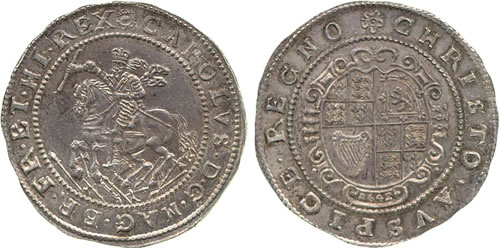
Auction: 3024 - The Slaney Collection of English Coins
Lot: 60
Charles I, Exeter mint, Halfcrown, 14.76g., m.m. rose, king holding marshal's baton, mounted on a spirited horse, galloping over arms which include a pistol, carolvs d g mag br fr et hi rex, rev. oval scroll garnished shield, date 1642 in small numerals in cartouche at bottom, christo avspice regno, no stops by reverse mintmark (Besly L28; JGB 1014 (same dies); N.2534; S.3071), a magnificent example in prooflike mint state, struck on an exceptional full round flan, with a lustrous silver tone, extremely rare, the finest known Estimate £12,500-15,000 provenance:
"Property of a Gentleman", Sotheby, 25 June 1895, lot 488
J G Murdoch, Sotheby, 8 June 1903, lot 159 ("must be the finest known specimen")
Dr E C Carter, collection purchased en bloc by Baldwin, 1950
This beautiful and artistic coin is one of the most famous and desirable products of the first English Civil War between Charles I and Parliament. Dated 1642 and produced to a standard far superior to that of the normal run of Royalist provincial issues, it has long puzzled numismatists both as to its background and to its true date of issue.
Only two provincial Royalist mints struck coins dated 1642, Shrewsbury and Oxford, but this piece does not correspond in any way to their output. Snelling, in 1762, illustrates an example under "unknown mints" and while he notes Folkes' suggestion that it was coined at York when the king set up his standard there, he prefers an attribution to Exeter due to the form of the mintmark rose, associated with that mint.
This attribution was confirmed by J B Bergne, NC. Vol.XII, with the discovery that the obverse die was subsequently used to strike a coin with an Exeter reverse die dated 1644, (Besly L25), however Exeter was only captured by Royalist forces under Prince Maurice on 4 September 1643 and the date remained a problem. This was solved in 1928 when Mary Coate published "The Royalist mints of Truro and Exeter", NC 5th ser. 8. She found, from access to the Vyvyan family papers, that on 14 November 1642 Sir Richard Vyvyan received a commission "to coin or cause to be coined in such place or places as convenient both gold and silver out of the bullion which might be delivered to him for the king's use.." and that coins were struck under this authority at Truro, the mint being transferred to Exeter after the capture of the City. The 1642 halfcrown was a Truro issue.
In 1992 Edward Besly published a complete reassessment of the mints of Truro and Exeter including a systematic study of the dies, BNJ 1992, pp.102-153. He found that the obverse die of the 1642 halfcrown can be dated somewhere between the late Truro period and well into 1644 when the letter punches started to be replaced. The placing of the two 1642 reverse dies is more precise. Both bear the fleur and English lion punches belonging to his group IIId, towards the end of the undated series. Nor are the reverse dies identical. The first, Besly L22 known from about fourteen specimens, bears the mintmark 'Truro' rose (3) and undamaged lions in the arms. The second, Besly L28 (this coin), known from seven specimens only, bears the mintmark 'Exeter' rose (4) and damaged lions. Besly shows conclusively that the 1642 halfcrown could not have been minted in 1642. It was struck at Exeter during 1644 and on apparently more than one occasion.
Helen Farquhar had already drawn attention to the similarity between the obverse design of the halfcrown and that of the Scottish Rebellion Medal, 1639, some of which are signed T S (Thomas Simon) (Medallic Illustrations, I, pp.282-3, 290-4). Both bear the distinctive equestrian portrait of the king holding a baton and galloping over a pile of arms, though the composition of the arms differ and on the halfcrown the king's hair flies out behind giving an illusion of speed, and it is accepted that the medal served as a model for the skilled but unknown hand who engraved the coinage die.
Michael Sharp has further suggested that, given the commemorative nature of the date and the way it forms an integral part of the shield containing the Royal arms, 1642 may refer to the raising of the king's standard at Nottingham on 22 August 1642 at the beginning of the Civil War. The association with the Scots Rebellion medal might underline this significance, 1639 being the last previous year in which the king's standard had been raised.
The reason why a coin of such exceptional execution and design, unparalleled in any other Civil War issue, should be produced at Exeter in 1644 is not certain. Besly refers to the personal visit of the King to Exeter in July 1644, and the Royalist victory over the Earl of Essex at Lostwithiel in the following month, but there still remains some mystery attached to this fascinating piece.
Sold for
£35,000




